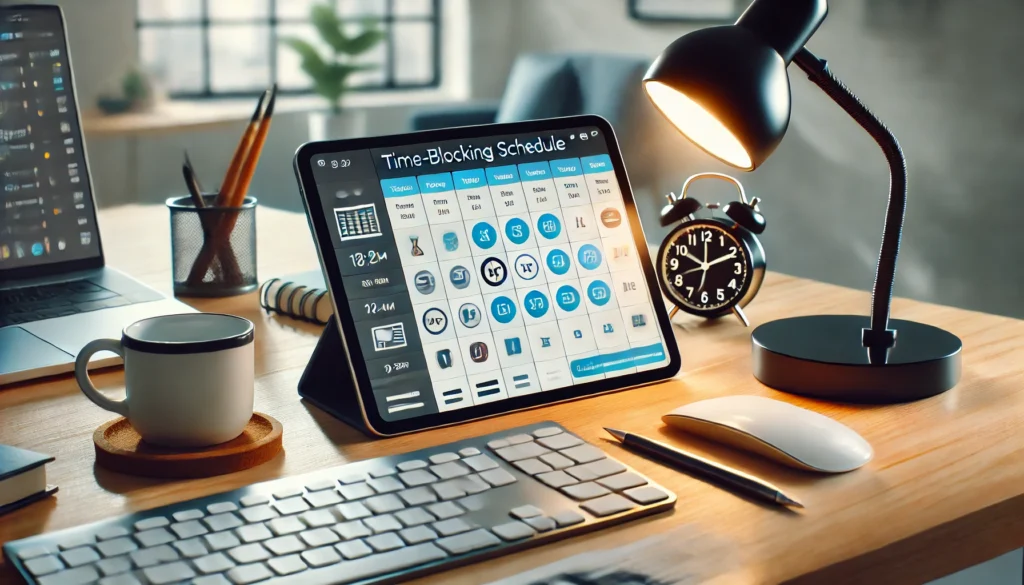Distractions can be categorized into two main types: external and internal. External distractions include noise, interruptions from others, and electronic devices. Internal distractions stem from our thoughts, emotions, and physical sensations. Understanding these categories is the first step in developing strategies to combat them.
You may also like: Mindfulness Techniques to Improve Attention Span
External Distractions: The Environmental Impact
External distractions primarily arise from the environment around us. This includes everything from the chatter of colleagues to the lure of social media notifications. Open office plans, while fostering collaboration, can also increase noise levels, making it harder to concentrate. Additionally, with the rise of remote work, home environments pose new challenges as household responsibilities and personal life can seep into work hours.
Internal Distractions: The Mental Clutter
Internal distractions are often more insidious as they originate from within. These include intrusive thoughts, stress, and anxiety that divert attention from the task at hand. Emotional states can fluctuate, causing our mind to wander, while physical sensations like hunger or discomfort can also break our focus. Acknowledging these distractions is the first step toward managing them effectively.
The Science Behind Distractions
Distractions are not just a modern phenomenon. Historically, humans have always faced interruptions, though the sources have evolved. The modern world, with its technological advancements, has exponentially increased the number of potential distractions. Neuroscience tells us that our brain is wired to seek novelty, making it challenging to focus on a single task for prolonged periods. The brain’s reward system releases dopamine when we switch tasks, reinforcing the habit of distraction.
Evolution of Human Focus
Throughout history, the nature of distractions has changed significantly. In ancient times, distractions were often external threats like predators, but today they are more likely to be digital notifications. Despite these changes, the human brain has remained relatively the same, with a natural tendency to seek out new information for survival. Understanding this evolution helps us appreciate why modern distractions can be so appealing and difficult to resist.
The Neuroscience of Distraction
Neuroscientists have found that distraction involves multiple areas of the brain, including the prefrontal cortex and the parietal lobe. These areas are responsible for attention control and task management. When distracted, the brain’s default mode network becomes active, leading to mind-wandering. This is because the brain is hardwired to respond to novelty, which can make it challenging to maintain prolonged focus on a single task.
Dopamine and Task Switching
Dopamine, a neurotransmitter in the brain, plays a crucial role in how we handle distractions. It is associated with the brain’s reward system and is released when we encounter new stimuli or switch tasks. This release makes task-switching feel rewarding, encouraging us to seek new distractions. Over time, this can create a cycle where our ability to focus is compromised, as we’re constantly seeking the next dopamine hit.
Strategies to Stop Getting Distracted
Prioritization and Task Management
One of the most effective ways to minimize distractions is through task prioritization. By organizing tasks based on their importance and urgency, you can focus on what’s truly essential. Tools like the Eisenhower Box can help in categorizing tasks into four quadrants: urgent and important, important but not urgent, urgent but not important, and neither urgent nor important. This method allows you to allocate your attention to tasks that require immediate focus.
Importance of Setting Clear Goals
Setting clear, achievable goals is crucial in task prioritization. By defining what you aim to achieve, you can better align your tasks with your objectives. Clear goals help in distinguishing between urgent and non-urgent tasks, ensuring that your focus remains on high-priority activities. Regularly reviewing and adjusting these goals can also help in maintaining a clear direction and minimizing distractions.
Utilizing Task Management Tools
Incorporating task management tools into your routine can significantly enhance your ability to prioritize effectively. Digital tools like Trello, Asana, or Todoist offer features that help organize tasks, set deadlines, and track progress. These platforms provide visual representations of tasks, making it easier to understand what’s important and what’s not, thereby reducing the temptation to get sidetracked by less critical activities.
Time Blocking for Enhanced Focus
Time blocking is a powerful technique that involves dedicating specific blocks of time to individual tasks. By scheduling your day in advance, you create a structured environment that minimizes the potential for distractions. This method encourages focused work sessions and helps prevent tasks from overlapping, allowing for a more productive and less chaotic workflow.
Creating a Distraction-Free Environment
Physical environments play a significant role in how well we can concentrate. To create a distraction-free zone, consider the following:
- Declutter your workspace: A tidy workspace minimizes visual distractions and helps in maintaining focus.
- Limit digital interruptions: Use apps and tools to block distracting websites and notifications during work hours.
- Control ambient noise: Use noise-canceling headphones or ambient noise apps to drown out background sounds.
The Power of Minimalism
Adopting a minimalist approach in your workspace can significantly reduce distractions. By removing unnecessary items and keeping only what is essential, you create a clean, organized space that promotes concentration. Minimalism helps in reducing visual clutter, making it easier to focus on the task at hand without being overwhelmed by excess stimuli.
Technology for a Focused Environment
While technology can be a source of distraction, it can also be a solution. Apps like Freedom or Cold Turkey can block access to distracting websites, while tools like Focus@Will provide music designed to enhance concentration. Leveraging technology to create a virtual barrier against distractions can be an effective strategy for maintaining focus.
Optimizing Lighting and Ergonomics
The physical setup of your workspace can also impact your ability to concentrate. Proper lighting, preferably natural light, can reduce eye strain and improve mood, while ergonomic furniture supports physical comfort. Ensuring that your workspace is comfortable and well-lit can help sustain attention and reduce the likelihood of internal distractions caused by discomfort or fatigue.
Attention Strategies and Mindfulness
Mindfulness is a powerful tool in combating distractions. By practicing mindfulness, you train your brain to focus on the present moment, reducing the pull of internal distractions.
- Mindful breathing: Take deep breaths and focus on your breathing for a few minutes before starting a task.
- Single-tasking: Instead of multitasking, dedicate your attention to one task at a time. This approach enhances concentration and improves task completion rates.

Developing a Mindfulness Routine
Incorporating mindfulness into your daily routine can greatly enhance focus. Start by setting aside a few minutes each day for mindfulness practices, such as meditation or mindful breathing. Gradually increase the duration as you become more comfortable. Consistency is key, as regular practice helps train the brain to remain present, reducing susceptibility to distractions.
The Benefits of Single-Tasking
Single-tasking, or focusing on one task at a time, can dramatically improve productivity. Multitasking often leads to divided attention and reduced efficiency. By committing to single-tasking, you allow your brain to fully engage with the task at hand, leading to higher quality work and a greater sense of accomplishment.
Incorporating Mindfulness in Daily Activities
Mindfulness doesn’t have to be limited to specific practices; it can be incorporated into daily activities. Whether it’s mindful eating, walking, or even listening, engaging fully in the present moment can help strengthen focus. By being mindful in everyday tasks, you enhance your ability to concentrate and reduce the likelihood of being distracted by irrelevant thoughts or stimuli.
Staying Focused in Class and Meetings
For students and professionals, staying focused during classes and meetings can be particularly challenging. Here are some strategies to stay engaged:
- Active participation: Engage in discussions, ask questions, and take notes to maintain focus.
- Scheduled breaks: Short breaks between classes or long meetings can help refresh your mind and maintain attention levels.
Techniques for Active Engagement
Active engagement is key to staying focused in educational and professional settings. Techniques such as summarizing information in your own words, making connections to prior knowledge, and asking clarifying questions can enhance understanding and retention. This active involvement not only keeps you alert but also helps internalize information more effectively.
The Role of Scheduled Breaks
Breaks are an essential component of maintaining focus during long periods of study or work. The Pomodoro Technique, which involves working for a set period followed by a short break, can help maintain high levels of concentration. Breaks allow the brain to process information and recharge, preventing burnout and enhancing productivity.
Utilizing Technology for Engagement
Incorporating technology in a structured way can also aid focus in classes and meetings. Tools like digital note-taking apps or interactive platforms can help organize information and facilitate active participation. By using technology thoughtfully, you can enhance engagement without falling into the trap of digital distractions.
Leveraging Technology to Stay on Task
While technology often contributes to distractions, it can also offer solutions. Numerous apps and tools are designed to enhance focus and productivity.
- Pomodoro Technique apps: These apps break work into intervals, traditionally 25 minutes, followed by a short break, helping maintain focus.
- Digital calendars and task managers: Tools like Google Calendar and Trello help in organizing tasks and setting reminders.
Apps for Time Management
Time management apps are invaluable tools for enhancing focus. Applications like RescueTime or Toggl help track how you spend your time, providing insights into productivity patterns. By identifying areas of improvement, these apps can assist in making informed adjustments to your workflow, minimizing time spent on distractions.
Enhancing Focus with Digital Tools
Various digital tools are specifically designed to improve concentration. Apps like Focus@Will use music neuroscience to increase focus, while browser extensions like StayFocusd limit time on distracting websites. By leveraging these tools, you can create a digital environment that supports, rather than hinders, your productivity.
Collaborative Platforms for Productivity
In team settings, collaborative platforms such as Slack or Microsoft Teams can enhance productivity by streamlining communication. These tools offer features like task assignments, file sharing, and project tracking, reducing the need for disruptive meetings and emails. Effective use of collaborative technology can help maintain focus on collective goals.
The Role of Physical Health in Maintaining Focus
Your physical health directly impacts your ability to concentrate. Here’s how you can optimize it:
Nutrition and Hydration
A balanced diet and adequate hydration are essential for optimal brain function. Foods rich in omega-3 fatty acids, antioxidants, and vitamins can boost cognitive performance. Staying hydrated ensures that your brain functions efficiently, improving focus and reducing fatigue.
Brain-Boosting Foods
Incorporating brain-boosting foods into your diet can enhance cognitive function. Foods like fatty fish, blueberries, and nuts are rich in nutrients that support brain health. Including these foods in your meals can improve memory and concentration, helping you stay focused throughout the day.
Importance of Regular Hydration
Hydration plays a vital role in maintaining focus and cognitive performance. Even mild dehydration can impair attention and short-term memory. Drinking water regularly throughout the day ensures that the brain functions at its best, reducing fatigue and improving clarity of thought.
Supplements for Cognitive Enhancement
For those looking to enhance cognitive function through nutrition, certain supplements may offer benefits. Omega-3 fatty acids, B vitamins, and ginkgo biloba are among the supplements associated with improved mental performance. However, it’s important to consult with a healthcare provider before starting any supplementation regimen.

Exercise and Sleep
Regular physical activity increases blood flow to the brain, enhancing cognitive function and reducing stress. Additionally, quality sleep is critical for maintaining attention and memory. Aim for 7-9 hours of sleep per night and incorporate physical activities like walking or yoga into your daily routine.
The Cognitive Benefits of Exercise
Exercise has numerous cognitive benefits, including improved attention, memory, and mental clarity. Activities like aerobic exercise, strength training, and yoga can enhance brain health by promoting neuroplasticity and reducing stress. Regular exercise can lead to sustained improvements in focus and overall cognitive function.
The Importance of Sleep Hygiene
Sleep hygiene is essential for maintaining focus and cognitive performance. Establishing a regular sleep schedule, creating a restful environment, and avoiding screens before bed can improve sleep quality. Prioritizing good sleep hygiene ensures that the brain is well-rested, enhancing attention and memory during waking hours.
Stress Reduction Through Physical Activity
Physical activity is an effective way to manage stress, which can be a significant source of internal distractions. Exercise releases endorphins, which improve mood and reduce stress levels. By incorporating regular physical activity into your routine, you can enhance your ability to concentrate and reduce the impact of stress-related distractions.
Nootropics and Supplements
For those interested in biohacking, nootropics and brain supplements can offer cognitive benefits. While research is ongoing, some popular nootropics include caffeine, L-theanine, and Rhodiola Rosea. However, it’s essential to consult with a healthcare professional before starting any supplementation.
Exploring Popular Nootropics
Nootropics are substances that claim to enhance cognitive function. Caffeine and L-theanine, often found in tea, are popular for their synergistic effects on focus and relaxation. Rhodiola Rosea, a natural adaptogen, is used for its potential to reduce fatigue and enhance mental performance. Researching and understanding these supplements can help in making informed decisions about their use.
Understanding the Risks and Benefits
While nootropics offer potential benefits, it’s important to understand the risks involved. Not all supplements have extensive scientific backing, and individual responses can vary. Consulting with healthcare professionals ensures that you choose supplements that are safe and suitable for your cognitive goals, minimizing potential adverse effects.
The Future of Cognitive Enhancement
The field of cognitive enhancement is rapidly evolving, with new discoveries and innovations on the horizon. Advances in personalized medicine and biotechnology may lead to more effective and targeted nootropics. Staying informed about these developments can help you make the most of emerging opportunities for cognitive enhancement.
Future Implications and Trends in Distraction Management
As technology continues to evolve, so too will the methods for managing distractions. Future trends may include advanced AI tools that predict and mitigate potential distractions, and more personalized strategies based on individual cognitive profiles. Understanding these trends can help you stay ahead in the quest for focus and productivity.
The Rise of AI in Focus Enhancement
Artificial intelligence is poised to play a significant role in distraction management. AI-driven apps can analyze user behavior and predict potential distractions, offering personalized solutions to enhance focus. These tools may adapt to individual needs, providing real-time adjustments to optimize attention and productivity in various settings.
Personalized Cognitive Strategies
Advancements in cognitive science may lead to more personalized strategies for distraction management. By understanding individual cognitive profiles, future tools could offer tailored solutions that align with personal strengths and challenges. This personalized approach can enhance the effectiveness of distraction management techniques, leading to greater productivity.
The Impact of Virtual Reality
Virtual reality (VR) technology holds promise for creating immersive environments that minimize external distractions. VR can simulate distraction-free settings, enabling users to engage fully with tasks. As this technology evolves, it may become an invaluable tool for focus enhancement, especially in educational and professional contexts.
Conclusion
Distractions are an inevitable part of life, but with the right strategies, you can minimize their impact. By prioritizing tasks, creating a conducive environment, practicing mindfulness, leveraging technology, and maintaining physical health, you can improve your focus and productivity. Whether you’re a health coach, journalist, or biohacker, these strategies offer practical solutions to stay on task and achieve your goals.
Implementing these strategies requires dedication and practice, but the rewards of improved concentration and efficiency are well worth the effort. Embrace these techniques to navigate the complexities of a distraction-filled world and emerge more focused and productive.
Commitment to Continuous Improvement
Staying focused is an ongoing process that requires continuous effort and adaptation. Regularly evaluating and refining your strategies ensures they remain effective and aligned with your goals. By committing to continuous improvement, you can overcome distractions and achieve lasting productivity.
The Role of Community and Support
Building a supportive community can enhance your ability to manage distractions. Sharing experiences and strategies with others facing similar challenges provides encouragement and accountability. Engaging with a community of like-minded individuals can offer valuable insights and motivation in your quest for focus.

Embracing a Mindful Lifestyle
Adopting a mindful lifestyle can help cultivate long-term focus and resilience to distractions. By integrating mindfulness practices into daily life, you develop a greater awareness of your thoughts and behaviors. This mindfulness enables you to respond more effectively to distractions, maintaining focus and achieving your objectives with clarity and purpose.
Further Reading:
How to Stop Getting Distracted While You Work
7 ways to avoid distractions and stay focused on studying
Eliminate distractions at work for your most productive day yet
Important Note: The information contained in this article is for general informational purposes only, and should not be construed as health or medical advice, nor is it intended to diagnose, prevent, treat, or cure any disease or health condition. Before embarking on any diet, fitness regimen, or program of nutritional supplementation, it is advisable to consult your healthcare professional in order to determine its safety and probable efficacy in terms of your individual state of health.
Regarding Nutritional Supplements Or Other Non-Prescription Health Products: If any nutritional supplements or other non-prescription health products are mentioned in the foregoing article, any claims or statements made about them have not been evaluated by the U.S. Food and Drug Administration, and such nutritional supplements or other health products are not intended to diagnose, treat, cure, or prevent any disease.


